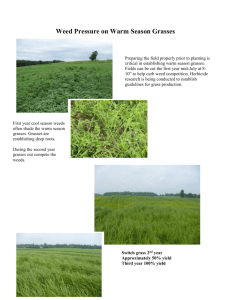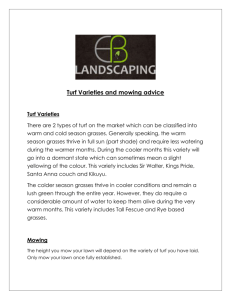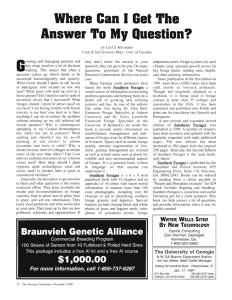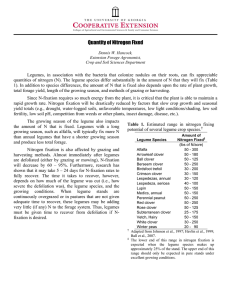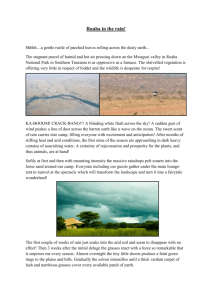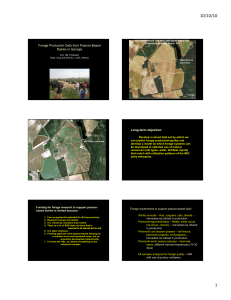FACTORS AFFECTING FORAGE QUALITY pp. 242 - 260
advertisement
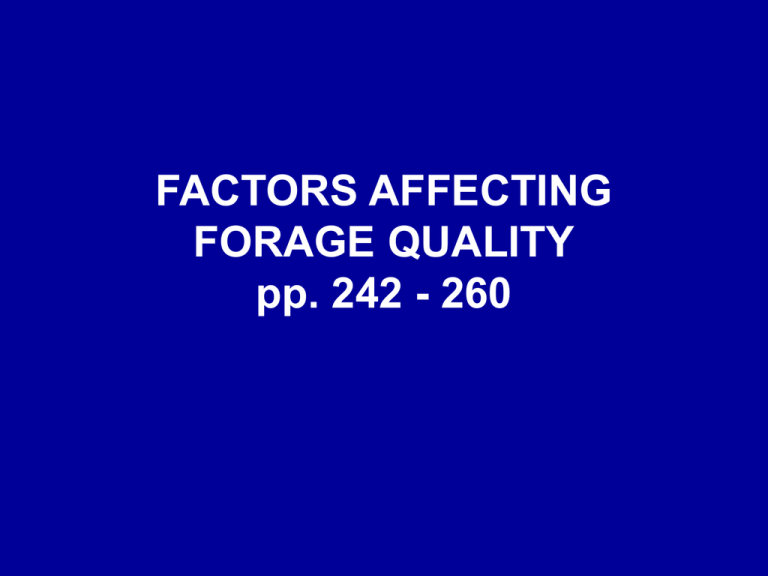
FACTORS AFFECTING FORAGE QUALITY pp. 242 - 260 FORAGES OR ROUGHAGES • General characteristics – Higher fiber concentration than energy and protein supplements – Lower energy concentration than energy or protein supplements – Lower protein concentration than protein supplements • May have higher or lower protein concentration than energy supplements • A high proportion of the protein in most forages is highly degraded in the rumen – Calcium concentration greater than energy and plant protein supplements – Concentration s of phosphorus and other minerals is highly variable – Concentrations of fat soluble vitamins high in fresh forages, but low after storage WHAT DEFINES FORAGE QUALITY? FACTORS DETERMINING FORAGE QUALITY • • • • Forage species Maturity Soil fertility Harvest method and quality of storage – Leaf-to-stem ratio – Nutrient preservation Total forage mass, lb/acre MAJOR CLASSES OF FORAGE SPECIES 3000 2000 1000 0 Jan Feb Mar Apr May Jun Jul Aug Sep Oct Nov Dec Months Cool season grass Legumes Warm season grass Stockpiled gr-leg (Hay equiv.) Corn stalks (Hay equiv.) NUTRITIONAL VALUE OF LEGUMES, COOL SEASON GRASSES, AND WARM SEASON GRASSES AT COMPARABLE MATURITIES DM basis CP, % NDF, % ADF, % ADL, % TDN, % NEm Mcal/ kg NEg Mcal/ kg Ca, % P, % Cool season grasses Immature 18 50 31 4 63 1.48 0.89 .72 .34 Mid-maturity 13 58 37 4 60 1.33 0.75 .66 .29 Mature 11 69 42 6 56 1.18 0.62 .47 .26 Immature 23 36 29 6 62 1.49 0.90 1.56 .31 Mid-maturity 21 43 33 6 59 1.38 0.80 1.37 .30 Mature 18 51 40 7 55 1.21 0.65 1.22 .28 Legumes Warm season grasses Immature 14 - - - 64 1.45 0.87 .63 .20 Mature 6 - - - 51 1.08 0.58 .40 .12 COOL SEASON GRASSES • Most common grasses in the Midwest – Kentucky bluegrass – Orchardgrass – Perennial ryegrass - Tall fescue -Smooth bromegrass - Reed canarygrass - Timothy • Growth – 66% of production occurs before early-June – Very low productivity in mid-summer – Some late season growth • Yields – Species effects Tall fescue Reed >Smooth bromegrass>Timothy>>Kentucky canarygrass Orchardgrass bluegrass – Very sensitive to soil fertility • N, P, and K • When is it needed??????? USES OF COOL SEASON GRASSES Grazing Harvest Kentucky bluegrass Excellent Poor Smooth bromegrass Excellent Excellent Orchardgrass Excellent Excellent Better mid-summer growth than other CSG Tall fescue Good Good Better fall growth than other CSG Reed canarygrass Good Good Grows well in wet environments Fair Excellent Preferred for horse hay Good Excellent Higher quality, but poorer persistence than other CSG Timothy Perennial ryegrass Comments NUTRITIONAL QUALITIES OF COOL SEASON GRASSES • General Compared to: Legume forages @ comparable maturity Grains Plant protein supplements CP Lower Greater/Lower Lower NDF Greater Greater Greater ADF Greater Greater Greater TDN/NE Lower Lower Lower Ca Lower Greater Comparable Comparable Comparable Lower P • Effects of fertility • N, P, K, Mg, and many trace minerals will affect their concentration in cool season grasses ANTI-QUALITY COMPONENTS IN COOL SEASON GRASSES • Endophyte fungus – Found in • Tall fescue • Perennial ryegrass – Produces toxic alkaloids • Classes – Lysergic acid amides – Ergopeptines » Ergovaline • Location – Primarily in the seed – Also in stem and leaf • Transfer to a pasture – Via the seed – Effects of fescue toxicosis • Physiological effects – Vasconstriction – High core body temperatures – Low heart rate – Low prolactin – Suppression of immune system • Results on animal – Hoof loss – Low forage intake and weight gains during summer – Retention of winter hair coat – Standing in water sources – Low milk production – Reproductive problems » Low pregnancy rate » Dystocia » Retained placenta – Management to prevent fescue toxicosis • • • • • Prevent excessive maturity of forage Limit application of N-fertilizer Plant or interseed legume forages in tall fescue pastures Rotate animals to non-fescue pastures Plant endophyte-free varieties of tall fescue – Poor persistence • Plant tall fescue varieties containing beneficial endophyte • Treatment of cattle with Ivermectin – A dewormer • Treatment of pregnant mares with Domperidone – Blocks receptors for dopamine • Tryptamine alkaloids – Common in native reed canarygrass varieties – Physiology • Serotonin receptor agonists • Can cause staggers or sudden death – Common effects on animal • Reduced feed intake and growth – Management • Plant low alkaloid varieties of reed canarygrass • Rotate animals for paddocks that do not contain reed canarygrass • Cobalt supplementation LEGUMES • Species – Alfalfa Red clover White clover Sweet clover Berseem clover • Growth Birdsfoot trefoil Sweet clover – Greatest in spring, but more uniform over the season than grasses • Yields Alfalfa > Red clover > Birdsfoot trefoil >> White clover Sweet clover • Fertility needs – N fertilization is not required • May reduce legume persistence in grass-legume pasture – Sensitive to pH, P, and K • Persistence – Very sensitive to management • Most species require some type of rest period to allow nutrient storage in roots and crown and/or reseeding • Competition with cool season grasses • Sensitive to most herbicides USES OF LEGUMES Species Grazing Harvest Comments Good Excellent Perennial, sensitive to wet conditions Red clover Excellent Good Biennial, sensitive to drought, easy to interseed Birdsfoot trefoil Excellent Good Perennial, but responds to management that allows reseeding Ladino & White clover Good Poor Perennial, less sensitive to close grazing than other legumes Sweet clover Poor Fair Biennial, less sensitive to soil conditions than other legumes Excellent Good Perennial, very persistent Fair Good Annual Alfalfa Kura clover Berseem clover NUTRITIONAL QUALITIES OF LEGUMES • General Compared to: Cool season grasses @ comparable maturity Grains Plant protein supplements CP Greater Greater Lower NDF Lower Greater Greater ADF Lower Greater Greater TDN/NE Greater Lower Lower Ca Greater Greater Greater Comparable Comparable Lower P • Effects of fertility • K fertility will affect its concentration in legumes NUTRITIONAL CONCERNS WITH LEGUME FORAGES • Bloat – Inability of ruminants to release fermentation gases – Occurs in ruminants consuming fresh, immature legumes like alfalfa, white clover, red clover, and kura clover – Caused by a high concentration of soluble protein in these legumes • Results in the formation of foam in the rumen • Inhibits eructation • Can result in death – Bloat prevention • • • • • • • • Plant mixtures of grasses and legumes Utilize non-bloating legumes Allow legumes to mature before grazing Feed animals some dry hay before placing animal on pastures Avoid moving animals into a pasture or paddock containing a high concentrations of legumes early in the morning Limit the daily forage allowance to the cattle Have water available in each paddock of a rotationally grazed pasture Make poloxalene available to animals grazing legumes – Sold as ‘Bloatguard’ – Available in blocks or supplements – Intake can be variable • Phytoestrogens – Present in alfalfa, red clover, and ladino clover – Have affected reproduction and mammary development in sheep • Coumarin – Present in sweet clover – Converted to dicoumarol in moldy sweet clover • Results in hemorrhaging in animals consuming the hay • Tannins – Present in birdsfoot trefoil – Reduce protein degradation in the rumen and feed intake WARM SEASON GRASSES • Warm season grasses – Perennial • Switchgrass Big bluestem Eastern gamagrass – Annual • Sudangrass Sorghum x Sudangrass • Growth – 70% of production occurs in June and July • Yields – Very productive – Very sensitive to soil fertility • N, P, and K • Persistence – Require rest – Competition with cool season grasses – Very sensitive to early harvest or grazing Corn USES OF WARM SEASON GRASSES Species Grazing Harvest Comments Switchgrass Fair Fair Perennial Big bluestem Good Fair Perennial Eastern gamagrass Good Fair Perennial Sorghum x Sudangrass Good Poor (Hay) Fair (Silage) Annual Sudangrass Good Poor (Hay) Fair (Silage) Annual Whole plant corn Excellent Excellent (Silage) Annual Corn stalks Excellent Fair (Baled) Good Silage Annual NUTRITIONAL QUALITIES OF WARM SEASON GRASSES Compared to: Cool season grasses @ comparable maturity Grains Plant protein supplements Lower Lower Lower NDF Greater (Lower for whole plant corn) Greater Greater ADF Greater (Lower for whole plant corn) Greater Greater Lower (Greater for whole plant corn) Lower Lower Comparable Lower Lower Lower Lower Lower CP TDN/NE Ca P NUTRITIONAL CONCERNS WITH WARM SEASON GRASSES • Cyanogenic glycosides – Present in new growth of sorghum x sudangrass and sudangrass forages • May be in spring growth or regrowth after harvest, drought or frost – Converted hydrocyanic acid (prussic acid) • Inhibits oxygen uptake by the hemoglobin – Management • Avoid grazing until forage is a minimum of 18 inches tall • Excessive corn intake – May occur in cattle grazing standing corn or grazing corn stalks fields with a large amount of fallen ears – May result in lactic acidosis or founder of the grazing animals – Management: • Limit grain intake by controlling access Annual Pasture Options ANNUAL FORAGES Species Species Digestible OM, % Grasses (Grazed, hay or silage): Annual ryegrass 70 Cereal rye 68 Brown midrib sorghum or 68 sorghum x sudan Wheat 66 Triticale 65 Oat 65 Legumes (Grazed, hay or silage): Berseem clover 60 Brassicas (Grazed): Turnips 71 Crude protein, % 20 22 12 9 9 9 17 21 LIMITATIONS OF ANNUAL FORAGES • May have limited production – Drought – Length of growing season before frost – Shading in standing row crop • Weather losses of nutrients – Problem with brassicas and berseem clover • Winter varieties must be killed before planting in the subsequent year – Unless reseeding is desired (Annual rye) • Limited spring use – Soil compaction – Late growth • Health problems – Bloat with brassicas and wheat – Goitrogens in brassicas Chicory • • • • A perennial broadleaf from sunflower family Drought resistant Persistent for three to four years Uses – Good for grazing – Poor for harvest • Good nutritional value: – 60 – 70% TDN – 13 – 16% CP MATURITY EFFECTS ON FORAGE QUALITY • Increasing forage maturity – Increases NDF • Reduces feed intake – Increases ADF and lignin • Reduces digestibility – Reduces CP and soluble carbohydrates • Reduces digestiblity EFFECTS OF MATURITY ON THE COMPOSITION OF FORAGES SB Alf Alf I M Maturity Alf SB I M Maturity Digestible DM, %DM 45 50 55 60 65 70 SB I M Maturity Alf SB I M Maturity CHANGES IN PLANT STRUCTURE WITH MATURITY Immature Mature Secondary cell wall (Cellulose) Cell Contents CC L L L L L L L L L Primary cell wall (Hemicellulose) Middle lamella (Lignin) L LIGNIN • A complex polymer of phenylpropane units • Binds to hemicellulose in cell wall – Needed to provide strength to plant • Increases with maturity • Reduces the digestibility of plant cell walls • Bonds to carbohydrates differ between forage species – Legumes • Ether linkages • Tough – Grasses • Ester linkages • Degraded by alkali treatment STRATEGIES TO MANAGE LIGNIN BEYOND CONTROLLING MATURITY • Alkali treatments – Mature grass, straw, corn stalks – Treatments • 3% anhydrous ammonia • 4% sodium hydroxide • 5% calcium oxide – Effects • Increase digestibility 10% • Increase intake 20% • Only effective on grass lignins – Economics • Profitable at high feed prices • Brown mid-rib varieties – Corn and Sorghum – Genetically engineered to have lower lignin content – Increases digestibility and intake of forage – Reduce stem strength

